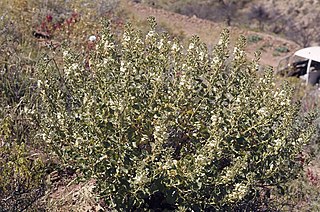
Prostanthera melissifolia, commonly known as balm mint bush, is a species of flowering plant in the family Lamiaceae and is endemic to south-eastern Australia. It is an erect shrub with hairy branches, egg-shaped leaves with fine teeth on the edges and mauve to purple or pink flowers on the ends of branchlets.

Prostanthera phylicifolia, commonly known as spiked mint-bush, is a species of plant in the family Lamiaceae. It is an erect shrub with four-ridged branches, narrow egg-shaped to oval leaves and white or pale lilac-coloured flowers with purple and yellow spots.

Persoonia arborea, commonly known as tree geebung, is a species of large shrub or small tree that is endemic to Victoria, Australia.

Prostanthera walteri, commonly known as blotchy mint-bush, is a species of flowering plant that is endemic to south-eastern Australia. It is a sprawling shrub with tangled, hairy branches, egg-shaped leaves and usually bluish green flowers with prominent purple veins arranged singly in leaf axils.

Prostanthera decussata, commonly known as dense mintbush, species of flowering plant that is endemic south-eastern Australia. It is a dense, compact, strongly aromatic shrub with egg-shaped leaves and mauve to violet flowers with yellow streaks, arranged in leaf axils near the ends of branchlets.
Persoonia brachystylis is a species of flowering plant in the family Proteaceae and is endemic to a restricted area on the west coast of Western Australia. It is an erect, spreading shrub with smooth bark, narrow spatula-shaped to lance-shaped leaves and yellow flowers in groups of ten to twenty.
Verticordia minutiflora is a flowering plant in the myrtle family, Myrtaceae and is endemic to the south-west of Western Australia. It is a bushy shrub with small, crowded, cylindrical leaves and groups of white to pale pink flowers in summer and autumn. As suggested by its botanical name, it has the smallest flowers of any verticordia.

Verticordia penicillaris is a flowering plant in the myrtle family, Myrtaceae and is endemic to the south-west of Western Australia. It is a small, widely spreading shrub, usually with several main branches. It is readily distinguished from other verticordias by its yellow flowers with white fringes and purple hairs on the end of their long styles.
Thryptomene johnsonii is a species of flowering plant in the family Myrtaceae and is endemic to a restricted area of Western Australia. It is a bushy shrub with rigid branches, egg-shaped leaves with the narrower end towards the base and pink flowers with five petals and usually eight stamens.

Petrophile megalostegia is a species of flowering plant in the family Proteaceae and is endemic to southwestern Western Australia. It is a shrub with needle-shaped or flattened, sometimes S-shaped leaves with a sharply-pointed tip, and more or less cylindrical heads of silky-hairy, yellow to cream-coloured flowers.

Isopogon crithmifolius is a species of plant in the family Proteaceae and is endemic to the south-west of Western Australia. It is a shrub with divided leaves and more or less spherical heads of glabrous reddish pink flowers.

Isopogon tridens, commonly known as the three-toothed coneflower, is a species of flowering plant in the family Proteaceae and is endemic to the southwest of Western Australia. It is a shrub with wedge-shaped leaves with two or three sharply-pointed teeth, and flattened-spherical heads of glabrous creamy white, sometimes purple flowers.

Leptospermum brachyandrum is a species of shrub or small tree that is endemic to eastern Australia. It has smooth bark, linear to lance-shaped leaves and white flowers and usually grows along creeks, often in water.

Rhadinothamnus euphemiae, is a slender, small, upright shrub with needle-shaped branchlets thickly covered with silvery scales and tubular greenish-purple tubular flowers throughout the year. It is endemic to the south coast of Western Australia.

Prostanthera canaliculata is a species of flowering plant in the family Lamiaceae and is endemic to the south-west of Western Australia. It is a small, erect shrub with hairy branchlets, narrow egg-shaped to narrow elliptical leaves and pale blue or pale violet to white flowers with no markings.

Prostanthera grylloana is a species of flowering plant in the family Lamiaceae and is endemic to Western Australia. It is a small, erect shrub with densely hairy branchlets, small, spatula-shaped leaves and red to pink flowers.
Petrophile multisecta, commonly known as Kangaroo Island conesticks, is a species of flowering plant in the family Proteaceae and is endemic to Kangaroo Island in South Australia. It is a prickly shrub with rigid, much-divided leaves with sharply pointed tips, oval to spherical heads of hairy cream-coloured flowers and oval fruit.

Goodenia chambersii is a species of flowering plant in the family Goodeniaceae and is endemic to South Australia. It is an ascending shrub with toothed, broadly egg-shaped to round leaves, racemes or thyrses of yellow flowers and oval fruit.
Thryptomene ericaea is a species of flowering plant in the family Myrtaceae and is endemic to South Australia. It is a shrub with narrow elliptic leaves and white flowers with five petals and five stamens.

Hibbertia desmophylla is a species of flowering plant in the family Dilleniaceae and is endemic to the south-west of Western Australia. It is a sprawling or erect, hairy shrub with spreading, densely clustered, linear leaves and yellow flowers with eleven to thirteen stamens.














